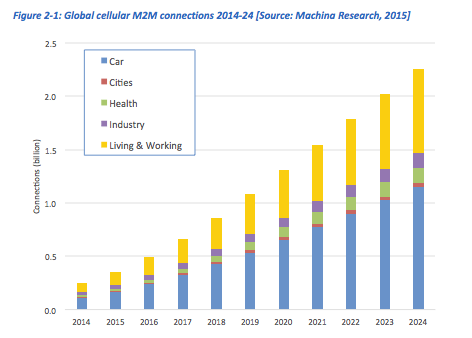The ability to avoid collisions is certainly a key component of the connected car. Autonomous driving aims to reduce vehicle crashes to zero, but what are the implications to the mobile networks supporting all of the data traffic created by these cars? A new report, released today by Teoco and Machina Research says this is an impending problem that can’t be ignored.
On the surface it sounds like there isn’t a problem. According to Machina Research, by 2024 machine-to-machine devices will account for 19% of the connections and only 4% of the traffic on mobile data networks. This is in comparison to 2014 when M2M devices accounted for 2% of usage. 
But when you dig a little deeper the issues become clearer – it isn’t the volume of data consumed, but rather the way in which the data is consumed. One example of the challenges mobile operators will face is the connected car. Consider a world where all of the vehicles are connected and chatting with each other about road and traffic conditions along the same stretch of roadway during commuting hours, presenting very high traffic spikes in a condensed location. Now there is a network resource management problem to ensure SLAs are met for the human users on the network in these cell sites. The mobile industry talks about signaling storms that can be caused by spikes in data traffic, and connected cars are certainly a driver of such concerns. Machina Research predicts that in this type of scenario, connected cars could monopolize 97% of data traffic. The full report can be downloaded via this link.
Now add a few unknowns, such as infotainment services and autonomous driving. Since we’re still in the early stages of these services, it’s yet to be determined the true bandwidth required.
Subscribe now to get the daily newsletter from RCR Wireless News
The report recommends the following:
- Dynamic network management and RAN optimization to ensure that network capacity is planned in order to ensure QoS during peak times.
- Diversity in access networks to not rely 100% on their 4G mobile networks and the possibility of adding small cell technology to aide in key locations. A mix of technologies licensed and unlicensed such as Wi-Fi and LPWAN.
- Implementation of network planning tools that are developed to take M2M traffic into consideration.
- Device management programs that address M2M devices with proper certification and testing to know they will work with their networks as expected.
- Spectrum refarming that addresses the longer lifespan of M2M devices as opposed to smartphones.
Connected cars is just one key example: M2M will have impacts on health care, industrial sites and agriculture locations that may not all be prepared for the higher data requirements coming their way because of their more rural locations. This story will continue to evolve as more functionality goes into the car and more information is transferred over the wireless networks.
Like what you read? Follow me on twitter!
Claudia Bacco, Managing Director – EMEA for RCR Wireless News, has spent her entire career in telecom, IT and security. Having experience as an operator, software and hardware vendor and as a well-known industry analyst, she has many opinions on the market. She’ll be sharing those opinions along with ongoing trend analysis for RCR Wireless News.

